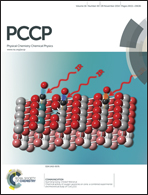Facile synthesis of V4+ self-doped, [010] oriented BiVO4 nanorods with highly efficient visible light-induced photocatalytic activity†
Abstract
Monodispersed monoclinic BiVO4 nanorods grown along the [010] direction were prepared using a one-step low temperature hydrothermal method in the presence of the low-cost, nontoxic sodium oleate serving as a chelating agent. The BiVO4 nanorods with diameters of 15–20 nm possess a huge specific surface area as large as 28.2 m2 g−1, which can endow them with high photocatalytic activity and strong adsorption of reactants. Meanwhile, the specific [010] growth direction is capable of facilitating efficient electron–hole separation by accumulating electrons on {010} facets. Thus, the highly efficient photocatalytic activity of the as-prepared BiVO4 nanorods under visible light, which far surpasses that of commercial P25, is demonstrated by the degradation of rhodamine B and phenol. Plentiful V4+ species, which can create oxygen vacancies, is detected implying that the as-obtained nanorods are self-doped BiVO4. Significantly, 61% of rhodamine B is adsorbed by the BiVO4 nanorods before irradiation owing to the appearance of plentiful O2− and OH− species on the surface adsorbed by oxygen vacancies. More excitingly, the excellent visible-light-driven photocatalytic activity of the as-obtained BiVO4 nanorods can be further elevated to an unprecedented level, roughly doubled, after applying a low temperature heat treatment process at 230 °C for 2 h and this improvement could primarily be ascribed to their optimized charge-carrier transport characteristics resulting from elevated crystallinity and decreased V4+ species.
![Graphical abstract: Facile synthesis of V4+ self-doped, [010] oriented BiVO4 nanorods with highly efficient visible light-induced photocatalytic activity](/en/Image/Get?imageInfo.ImageType=GA&imageInfo.ImageIdentifier.ManuscriptID=C4CP03795B&imageInfo.ImageIdentifier.Year=2014)

 Please wait while we load your content...
Please wait while we load your content...